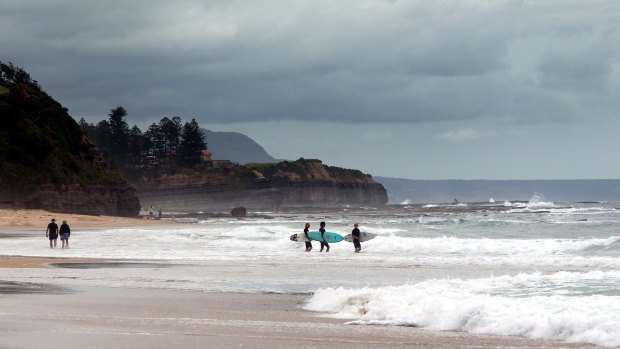This was published 9 years ago
Thirroul, New South Wales: Travel guide and things to do

Thirroul, NSWCredit: Sylvia Liber
Thirroul lies on the coast 69 km south of Sydney. The name derives from an Aboriginal word, 'Thurrural' said to mean 'the Valley of the Cabbage Tree Palms'. Once a coalmining settlement it is now a transitional area between the escarpment 'villages' to the north and the true suburbia to the south.
Thirroul has long been a beach resort - it became a popular holiday destination after the railway came through in the early 1880's - although its proximity to industrialised Wollongong meant that it was largely ignored until the arrival of the electric train service in 1987. As it is the major train stop of the Illawarra's outer northern suburbs it has become a focal point for the growing legions of Sydneysiders who now commute from an increasingly desirable, and expensive, commuter region.
This area was originally inhabited by the Wodi Wodi Aborigines and it is from their language that we received the word 'Thurrural', said to mean 'the Valley of the Cabbage Tree Palms'. When Captain James Cook sailed up the eastern coast of Australia in 1770, the ship's botanist, Joseph Banks, confirmed the presence of the Aborigines and the predominance, in the area, of this tree type:
'The country today again made in slopes to the sea...The trees were not very large and stood separate from each other without the least underwood; among them we could discern many cabbage trees but nothing else which we could call by any name. In the course of the night many fires were seen'.
The first Europeans to live in the district were escaped convicts (for a lengthier history of the area see the entry on Bulli).
The Seaside and Arts Festival is held at Thirroul each April.
Things to see
Tourist Information
There is a tourist information centre in Wollongong, tel: (02) 4228 0300.
'Wyewurk' - D.H. Lawrence's House
Thirroul's greatest claim to historical fame was the residence, from May to August 1922, of the novelist D.H. Lawrence at 3 Craig St. This pleasant house, a Californian-style bungalow with very strong Australian Federation overtones, is still named 'Wyewurk'. It was here that Lawrence wrote most of his Australia-based novel Kangaroo. The house is now privately owned and therefore not open for inspection.
Looked at from the street the visitor gets no idea of the magnificence of the view from the front garden. However if you go to the southern end of the street there is a small park (plans are set to erect a Lawrence memorial here). Some steps at the edge of the park allow visitors an opportunity to appreciate the view and, like Lawrence, to walk on one of Thirroul's most charming and less populated beaches and around the rocks directly below the house. His description of this location is powerful and evocative:
'He liked the sea, the pale sea of green glass that fell in such cold foam. Ice-fiery, fish-burning. He went out on to the low flat rocks at low tide, skirting the deep pock-holes that were full of brilliantly clear water and delicately-coloured shells and tiny, crimson anemones. Strangely sea-scooped sharp sea-bitter rock floor, all wet and sea-savage'.
Of 'Wyewurk' Lawrence observed: 'The house inside was dark, with its deep verandahs like dark eyelids half closed...overlooking the huge rhythmic Pacific'. The house cannot be seen from the beach as it is protected by two glorious Norfolk pines that frame the view which the residents enjoy from the front garden and verandah.
Anyone interested in a more detailed account of his stay in Wyewurk should read Robert Darrock's D.H. Lawrence in Australia, Macmillan Australia, Melbourne, 1981.
If you are approaching Thirroul from the bottom of Bulli Pass (from the south) turn right at the second set of traffic lights into Raymond Rd. If you are coming from the north along Lawrence Hargrave Drive this is the first set of lights. Either way, drive to the end of Raymond Rd and turn left. At the next T-intersection turn right and at the third T-junction turn left, then take the first right into Craig St. 'Wyewurk' is the second house on the left.
Thirroul's other dubious claim to fame is that the famous twentieth-century Australian painter Brett Whiteley died at the Oral Eagle Motel (now the Thirroul Beach Motel) in 1992.
Sandon Point
At the southern end of Craig St follow the road as it bends sharply to the right, becoming Tasman Parade, then take the first left and follow the road to the end. A bridge leads across an inlet to the Sandon Point which is one of the area's prime surfing beaches. It is a pleasant spot for a stroll south along the beach to the rocks and up the hillside to a viewing area up and down the coast.
Thirroul Beach
If you return to the northern end of Craig St and turn right the road immediately bends to the left as Cliff Parade. At the bottom of the hill is a large park with children's play facilities. Adjacent are a large swimming pool, an eatery and the main beach.
Sign up for the Traveller Deals newsletter
Get exclusive travel deals delivered straight to your inbox. Sign up now.